The Hills are Alive!
but not for long... SQUAD! OPEN FIRE!
Anyway. Salzburg.
Please note that this somewhat belated edition of The Wonderful World of Germany Except In This Case Austria now has photos!
The first destination after Munich was Salzburg. Salzburg is quite well known for several reasons, some of which you may know, others you may not. It is:
1. The birthplace of Mozart, and also contributed strongly to his upbringing
2. In the past, a considerably wealthy salt-mining town
3. The setting for The Sound of Music
4. One of the most beautiful places in the known world
All of these things, of course, mean that is geared to tourists of all manner, from highly cultured persons who wish to indulge in some of Mozart's operas and pieces in their original performance locations, to those who want to take a gander at the fields where Maria the Singing Nun strolled around, thus dooming generations of children to the banshee-like screeches of their mothers singing in tandem.
In retrospect I probably shouldn't have told mum where to find my journal.
So, a little bit of history on Salzburg is probably necessary. There used to exist a thing called the Holy Roman Empire which was, in essence, a collection of principalities that only had Catholocism as the common factor between them. Salzburg was one of these principalities, and it was ruled by a series of Prince-Archbishops. These Prince-Archbishops were put in place by the Pope originally, but after that I think it remained largely hereditary, and they were the undisputed dictators of Salzburg. During the time that Mozart was around, Salzburg was still an independent principality so technically, Mozart was not an Austrian. Apparently rather few Austrians actually know this.
The many different Prince-Archbishops, despite being put in place by the Pope and theoretically being glorified preachers, ended up being the undisputed rulers and basically doing whatever they wanted. There is a rather beautiful palace called Mirabell Schloss which one of them built for his mistress, and apparently had about 16 children by her. Another of them built a trick set of seats around a table... there was a law that no-one was allowed to stand during meals with the Prince-Archbishop, so he decided to create these seats with holes in the bottom that would spurt water onto the backsides of those sharing his company. Apparently there were several peasant rebellions over the years. Not surprising, really.
Now, a picture!
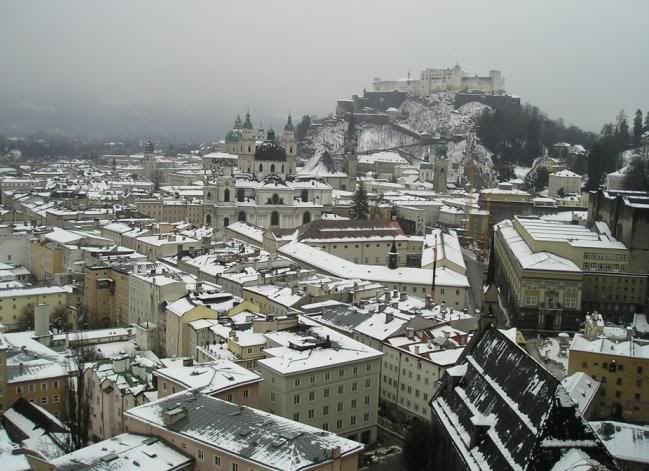
The feature that dominates the town of Salzburg is the fortress just above the old part of town, or the Altstadt as they call it. This was where the Prince-Archbishops would retreat to when enemy forces, or their own peasants even, came knocking on the door. It saw quite extensive reconstructions and additions over the years as successive Prince-Archbishops became increasingly paranoid. The fortress has never in its existence been overwhelmed by enemy forces, but this is only on a technicality... when Napoleon came marching through the region, Salzburg realised that it could not possibly be victorious so they surrendered in advance, and thus rather neatly managed to maintain the "undefeated" tag on their beloved fortress.
Salzburg itself managed to live quite prosperously due to its salt mining operations. I'm sure you all know this, but the word 'Salary' comes from 'Salt', as people used to be paid in it. It was, essentially, mining your own money, and salt was important for all manner of reasons, from preserving food to actually making things taste any good. The restaurant of the hotel in which we stayed was quite tastefully arranged in a salt mining theme. According to Dad, salt used to be worth its weight in silver, and pepper worth its weight in gold. How things change.
We ended up visiting the salt mines while in Salzburg. Well, actually, we had to go off to Berchtesgaden, which is famously where Hitler had his summer retreat (the Eagle's Nest) and is in Bavaria. It was here that I learnt that Hitler was a vegetarian, which is a useful fact if there are any self-righteous vegetarians you want to annoy. Nowadays they don't mine out the salt like they traditionally did, they drill a big hole in the ground and fill it with water until the salt dissolves into brine, then pump the brine out to be processed. Much safer that way. Dad took quite a few photos down in the mines, many of which are boring ones of mining equipment, so I won't show too many of them.
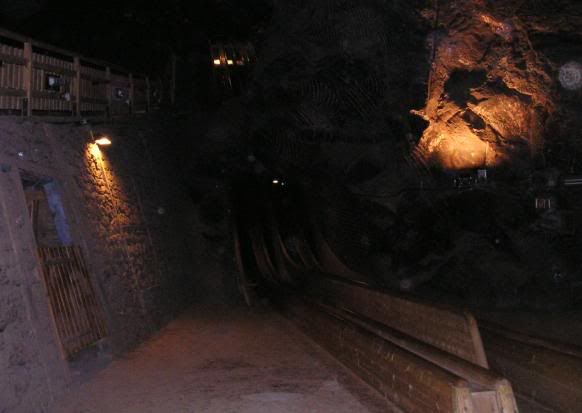
The above photo was taken in the salt mines, and shows one of the slides that the miners had to take to get down to the bottom, back when everything was still done by hand. You would go down this in pairs, and make sure to keep your legs up as you went down. It was pretty fun actually, and far safer than it looks.
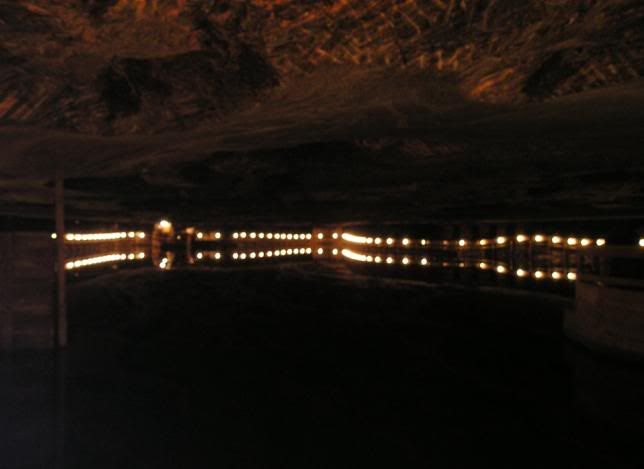
This photo was taken while travelling on one of the underground lakes that they have from which the brine is pumped out of. This one's no longer in use for anything other than the salt mine museum, though.
Another thing we did was to go on the Sound of Music tour, as Dad and I couldn't go to Salzburg without doing it; Mum would never forgive us otherwise. As a result, I am now full with all manner of useless trivia about this film, which is, in traditional Hollywood style, packed to the brim with historical inaccuracies as well as complete fabrications. We ended up visiting key locations throughout Salzburg and the surrounding areas, including a few small towns, and despite the somewhat snowy weather it was quite beautiful to behold.
Our tour guide seemed to be a bit nuts, but I guess anyone would be after having to take a busload of tourists to do a Sound of Music tour and listening to the soundtrack from the movie every day for however long he's been doing it for.
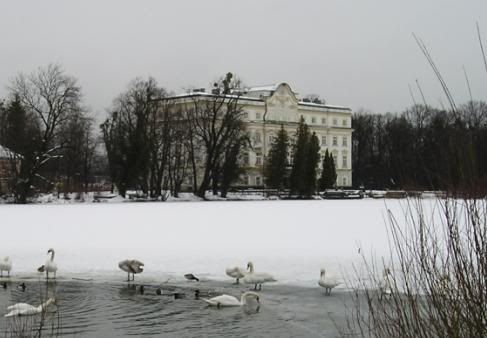
This is a photo of the house that was used in The Sound of Music. Their actual house was, of course, far more modest. The house here is actually now owned by Harvard University, and English-only lectures on American history are now conducted in it.
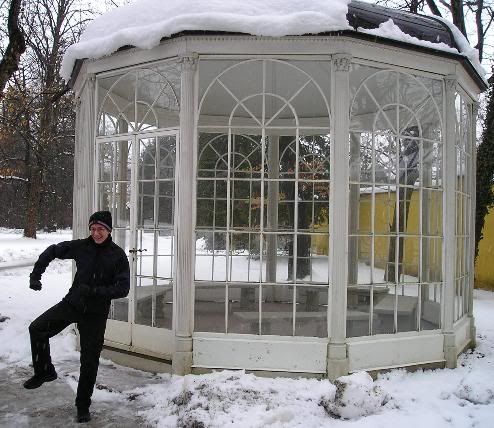
This here is the gazebo used in the song 'Sixteen, Going On Seventeen' in SoM. If it looks smaller than it should be, that's because they used a lot of mirrors and trick photography to make it appear larger; this is the actual gazebo used in the Hollywood film studio. There is a rambling annecdote related to this gazebo, but now is not the time.
Another thing we did in Salzburg was to climb up into the fortress on top of the hill and have a look around. There was a considerable amount of information up there as well; museums, walks, exhibits and the like. They had a rather interesting marionette museum and we got some spectacular photographs of the view from the fortress, which follow. They would be far more spectacular if the weather was better. We will need to come back in Spring, methinks.
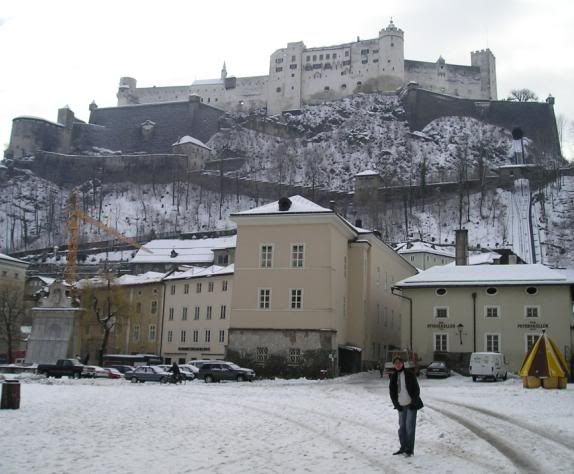
Above is the fortress. In order to get up, we would have to take a funicular (which is a train that goes up the side of the mountain for those like me who didn't know). Damn that's a cool fortress.
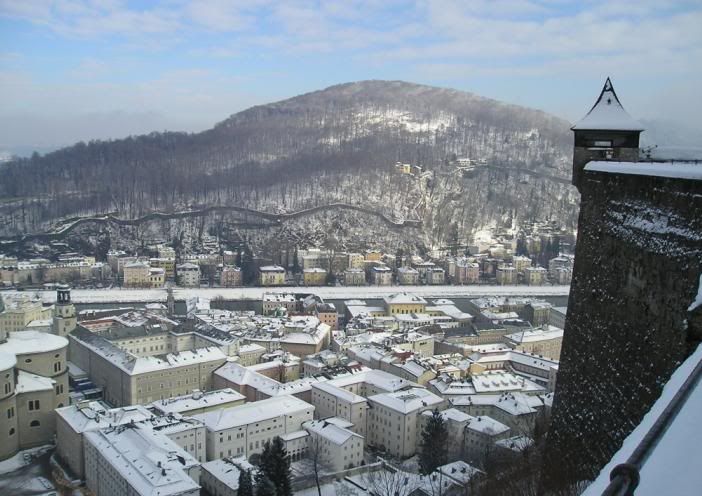
In this photo you can see the wall that was constructed in the mountainside. The great thing about travelling in Europe is that wherever you go, there is at least several hundred years of history that is plainly visible.
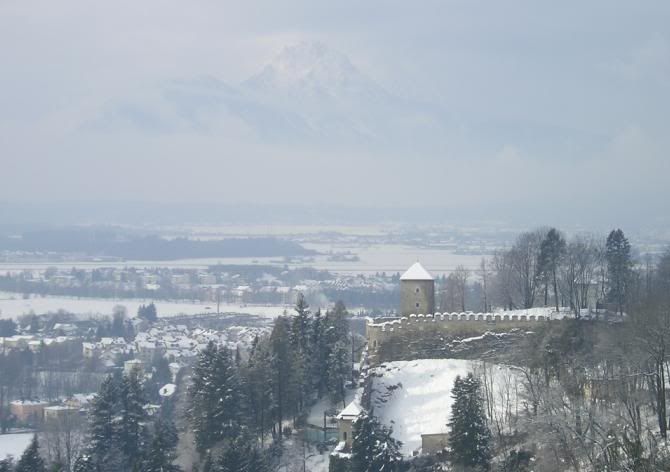
In this photo you can see a hint of the mountains around the place. We really, really need to come back in Spring.
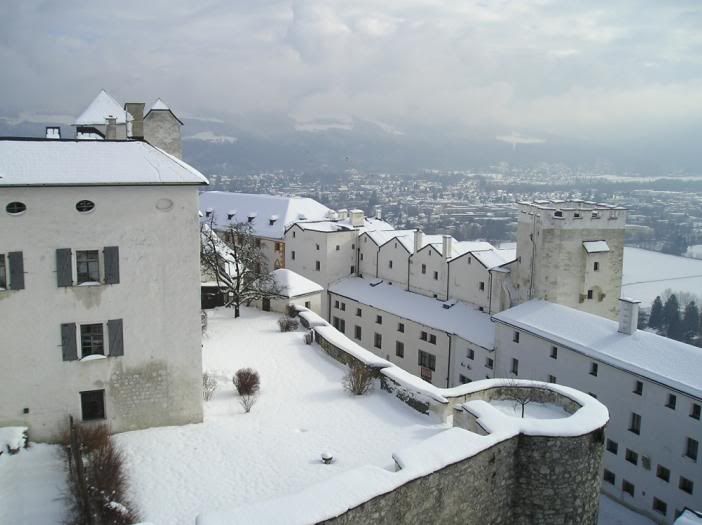
Most of this photo is of the courtyard inside the fortress.
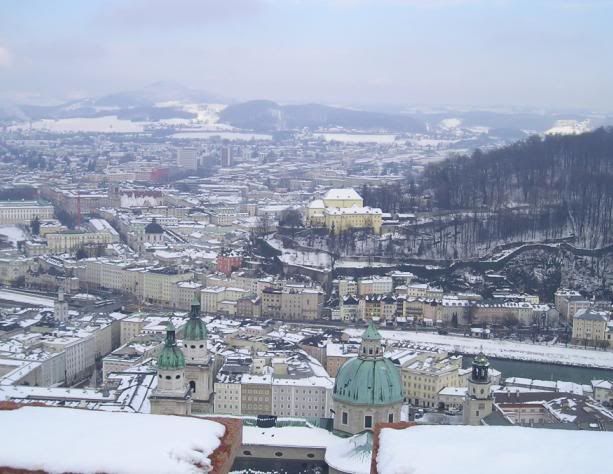
And one more photo
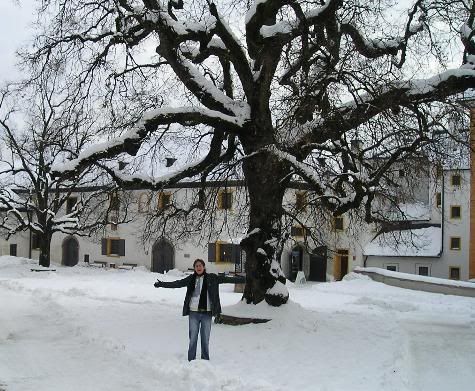
This is part of the courtyard inside the fortress. Salzburg certainly knows how to make a good castle.
In Salzburg we also took part in what was probably the most culturally sophisticated event for the whole trip. In Mirabell Palace (the one the Prince-Archbishop built for his mistress), we watched a string quartet perform a few of Mozart's pieces in what was quite possibly the very room that Mozart himself would have performed them in. Naturally, Dad and I were attired in our finest clothes; Dad in the wrinkled blue shirt he'd washed that morning just for the occasion, and I was wearing only the finest articles demonstrating my level of musical appreciation, namely my Radiohead shirt and The Doors jumper. We looked the part, I tell you. The way people kept looking at us, you could just tell they were nauseous with envy. It was probably a good thing that the next day were on our way out to Mittenwald, because we surely could not have kept up such a glorious facade for long.
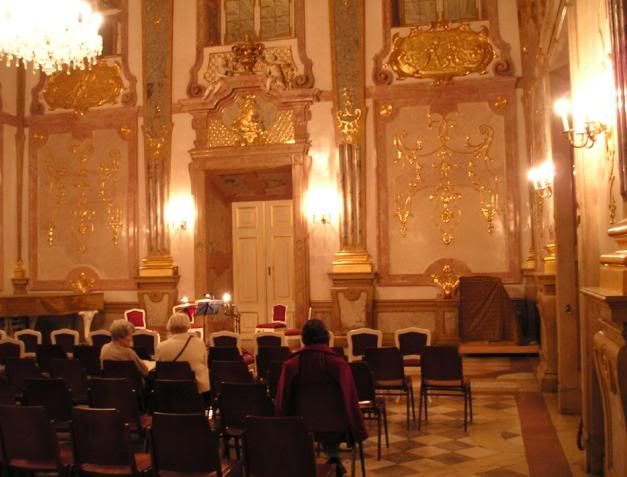
This here is the performance hall of the Mirabell Palace.
There are of course many more photos of Salzburg, but I quite frankly don't want to spend so much time recounting them. Next part of the trip was Mittenwald, where we did a bit of skiing, and that will be the next update. Bye!
Anyway. Salzburg.
Please note that this somewhat belated edition of The Wonderful World of Germany Except In This Case Austria now has photos!
The first destination after Munich was Salzburg. Salzburg is quite well known for several reasons, some of which you may know, others you may not. It is:
1. The birthplace of Mozart, and also contributed strongly to his upbringing
2. In the past, a considerably wealthy salt-mining town
3. The setting for The Sound of Music
4. One of the most beautiful places in the known world
All of these things, of course, mean that is geared to tourists of all manner, from highly cultured persons who wish to indulge in some of Mozart's operas and pieces in their original performance locations, to those who want to take a gander at the fields where Maria the Singing Nun strolled around, thus dooming generations of children to the banshee-like screeches of their mothers singing in tandem.
In retrospect I probably shouldn't have told mum where to find my journal.
So, a little bit of history on Salzburg is probably necessary. There used to exist a thing called the Holy Roman Empire which was, in essence, a collection of principalities that only had Catholocism as the common factor between them. Salzburg was one of these principalities, and it was ruled by a series of Prince-Archbishops. These Prince-Archbishops were put in place by the Pope originally, but after that I think it remained largely hereditary, and they were the undisputed dictators of Salzburg. During the time that Mozart was around, Salzburg was still an independent principality so technically, Mozart was not an Austrian. Apparently rather few Austrians actually know this.
The many different Prince-Archbishops, despite being put in place by the Pope and theoretically being glorified preachers, ended up being the undisputed rulers and basically doing whatever they wanted. There is a rather beautiful palace called Mirabell Schloss which one of them built for his mistress, and apparently had about 16 children by her. Another of them built a trick set of seats around a table... there was a law that no-one was allowed to stand during meals with the Prince-Archbishop, so he decided to create these seats with holes in the bottom that would spurt water onto the backsides of those sharing his company. Apparently there were several peasant rebellions over the years. Not surprising, really.
Now, a picture!

The feature that dominates the town of Salzburg is the fortress just above the old part of town, or the Altstadt as they call it. This was where the Prince-Archbishops would retreat to when enemy forces, or their own peasants even, came knocking on the door. It saw quite extensive reconstructions and additions over the years as successive Prince-Archbishops became increasingly paranoid. The fortress has never in its existence been overwhelmed by enemy forces, but this is only on a technicality... when Napoleon came marching through the region, Salzburg realised that it could not possibly be victorious so they surrendered in advance, and thus rather neatly managed to maintain the "undefeated" tag on their beloved fortress.
Salzburg itself managed to live quite prosperously due to its salt mining operations. I'm sure you all know this, but the word 'Salary' comes from 'Salt', as people used to be paid in it. It was, essentially, mining your own money, and salt was important for all manner of reasons, from preserving food to actually making things taste any good. The restaurant of the hotel in which we stayed was quite tastefully arranged in a salt mining theme. According to Dad, salt used to be worth its weight in silver, and pepper worth its weight in gold. How things change.
We ended up visiting the salt mines while in Salzburg. Well, actually, we had to go off to Berchtesgaden, which is famously where Hitler had his summer retreat (the Eagle's Nest) and is in Bavaria. It was here that I learnt that Hitler was a vegetarian, which is a useful fact if there are any self-righteous vegetarians you want to annoy. Nowadays they don't mine out the salt like they traditionally did, they drill a big hole in the ground and fill it with water until the salt dissolves into brine, then pump the brine out to be processed. Much safer that way. Dad took quite a few photos down in the mines, many of which are boring ones of mining equipment, so I won't show too many of them.

The above photo was taken in the salt mines, and shows one of the slides that the miners had to take to get down to the bottom, back when everything was still done by hand. You would go down this in pairs, and make sure to keep your legs up as you went down. It was pretty fun actually, and far safer than it looks.

This photo was taken while travelling on one of the underground lakes that they have from which the brine is pumped out of. This one's no longer in use for anything other than the salt mine museum, though.
Another thing we did was to go on the Sound of Music tour, as Dad and I couldn't go to Salzburg without doing it; Mum would never forgive us otherwise. As a result, I am now full with all manner of useless trivia about this film, which is, in traditional Hollywood style, packed to the brim with historical inaccuracies as well as complete fabrications. We ended up visiting key locations throughout Salzburg and the surrounding areas, including a few small towns, and despite the somewhat snowy weather it was quite beautiful to behold.
Our tour guide seemed to be a bit nuts, but I guess anyone would be after having to take a busload of tourists to do a Sound of Music tour and listening to the soundtrack from the movie every day for however long he's been doing it for.

This is a photo of the house that was used in The Sound of Music. Their actual house was, of course, far more modest. The house here is actually now owned by Harvard University, and English-only lectures on American history are now conducted in it.

This here is the gazebo used in the song 'Sixteen, Going On Seventeen' in SoM. If it looks smaller than it should be, that's because they used a lot of mirrors and trick photography to make it appear larger; this is the actual gazebo used in the Hollywood film studio. There is a rambling annecdote related to this gazebo, but now is not the time.
Another thing we did in Salzburg was to climb up into the fortress on top of the hill and have a look around. There was a considerable amount of information up there as well; museums, walks, exhibits and the like. They had a rather interesting marionette museum and we got some spectacular photographs of the view from the fortress, which follow. They would be far more spectacular if the weather was better. We will need to come back in Spring, methinks.

Above is the fortress. In order to get up, we would have to take a funicular (which is a train that goes up the side of the mountain for those like me who didn't know). Damn that's a cool fortress.

In this photo you can see the wall that was constructed in the mountainside. The great thing about travelling in Europe is that wherever you go, there is at least several hundred years of history that is plainly visible.

In this photo you can see a hint of the mountains around the place. We really, really need to come back in Spring.

Most of this photo is of the courtyard inside the fortress.

And one more photo

This is part of the courtyard inside the fortress. Salzburg certainly knows how to make a good castle.
In Salzburg we also took part in what was probably the most culturally sophisticated event for the whole trip. In Mirabell Palace (the one the Prince-Archbishop built for his mistress), we watched a string quartet perform a few of Mozart's pieces in what was quite possibly the very room that Mozart himself would have performed them in. Naturally, Dad and I were attired in our finest clothes; Dad in the wrinkled blue shirt he'd washed that morning just for the occasion, and I was wearing only the finest articles demonstrating my level of musical appreciation, namely my Radiohead shirt and The Doors jumper. We looked the part, I tell you. The way people kept looking at us, you could just tell they were nauseous with envy. It was probably a good thing that the next day were on our way out to Mittenwald, because we surely could not have kept up such a glorious facade for long.

This here is the performance hall of the Mirabell Palace.
There are of course many more photos of Salzburg, but I quite frankly don't want to spend so much time recounting them. Next part of the trip was Mittenwald, where we did a bit of skiing, and that will be the next update. Bye!